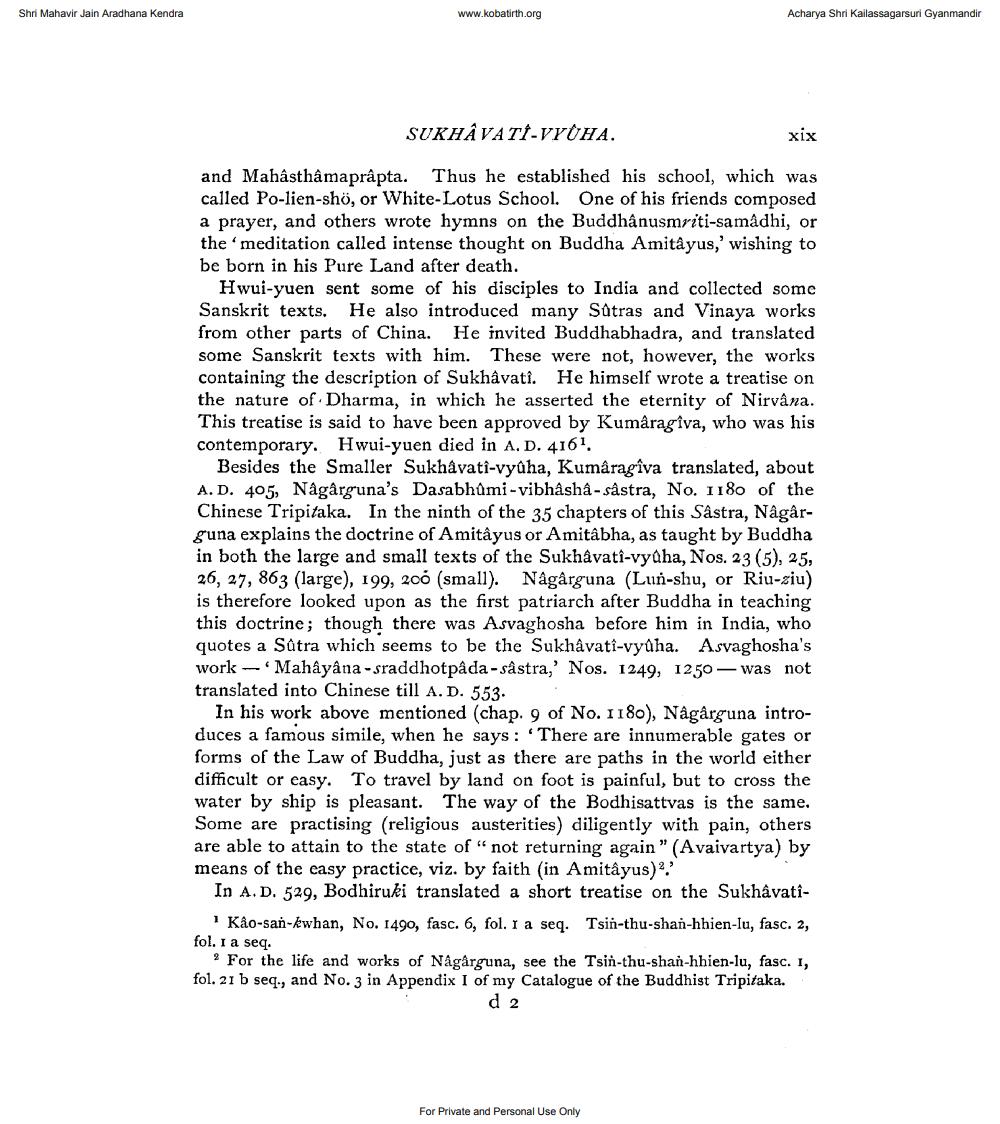________________
Shri Mahavir Jain Aradhana Kendra
www.kobatirth.org
Acharya Shri Kailassagarsuri Gyanmandir
SUKHÂVATI-VYUHA.
xix
and Mahasthamaprapta. Thus he established his school, which was called Po-lien-shö, or White-Lotus School. One of his friends composed a prayer, and others wrote hymns on the Buddhânusmriti-samadhi, or the meditation called intense thought on Buddha Amitäyus,' wishing to be born in his Pure Land after death.
Hwui-yuen sent some of his disciples to India and collected some Sanskrit texts. He also introduced many Sutras and Vinaya works from other parts of China. He invited Buddhabhadra, and translated some Sanskrit texts with him. These were not, however, the works containing the description of Sukhâvati. He himself wrote a treatise on the nature of Dharma, in which he asserted the eternity of Nirvana. This treatise is said to have been approved by Kumaragiva, who was his contemporary. Hwui-yuen died in A. D. 4161.
Besides the Smaller Sukhavati-vyuha, Kumâragîva translated, about A.D. 405, Nagârguna's Dasabhůmi - vibhasha - sastra, No. 1180 of the Chinese Tripitaka. In the ninth of the 35 chapters of this Sastra, Nagarguna explains the doctrine of Amitâyus or Amitabha, as taught by Buddha in both the large and small texts of the Sukhâvatî-vydha, Nos. 23 (5), 25, 26, 27, 863 (large), 199, 200 (small). Nagârguna (Lun-shu, or Riu-ziu) is therefore looked upon as the first patriarch after Buddha in teaching this doctrine; though there was Asvaghosha before him in India, who quotes a Sútra which seems to be the Sukhavati-vyuha. Asvaghosha's work - Mahayana-sraddhotpada-sastra,' Nos. 1249, 1250 — was not translated into Chinese till A.D. 553.
In his work above mentioned (chap. 9 of No. 1180), Nagârguna introduces a famous simile, when he says: There are innumerable gates or forms of the Law of Buddha, just as there are paths in the world either difficult or easy. To travel by land on foot is painful, but to cross the water by ship is pleasant. The way of the Bodhisattvas is the same. Some are practising (religious austerities) diligently with pain, others are able to attain to the state of “not returning again" (Avaivartya) by means of the casy practice, viz. by faith (in Amitâyus)?? In A.D. 529, Bodhiruki translated a short treatise on the Sukhavati
Kâo-san-kwhan, No. 1490, fasc. 6, fol. I a seq. Tsin-thu-shan-hhien-lu, fasc. 2, fol. I a seq.
For the life and works of Nâgârguna, see the Tsin-thu-shan-hhien-lu, fasc. I, fol. 21 b seq., and No. 3 in Appendix I of my Catalogue of the Buddhist Tripitaka.
d 2
For Private and Personal Use Only




